

Compact Muon Solenoid
LHC, CERN
| CMS-SUS-16-045 ; CERN-EP-2017-158 | ||
| Search for supersymmetry with Higgs boson to diphoton decays using the razor variables at $\sqrt{s} = $ 13 TeV | ||
| CMS Collaboration | ||
| 1 September 2017 | ||
| Phys. Lett. B 779 (2018) 166 | ||
| Abstract: An inclusive search for anomalous Higgs boson production in the diphoton decay channel and in association with at least one jet is presented, using LHC proton-proton collision data collected by the CMS experiment at a center-of-mass energy of 13 TeV and corresponding to an integrated luminosity of 35.9 fb$^{-1}$. The razor variables $M_{{\mathrm{R}} }$ and ${{\mathrm{R}} }^2$, as well as the momentum and mass resolution of the diphoton system, are used to categorize events into different search regions. The search result is interpreted in the context of strong and electroweak production of supersymmetric particles. We exclude bottom squark pair-production with masses below 450 GeV for bottom squarks decaying to a bottom quark, a Higgs boson, and the lightest supersymmetric particle (LSP) for LSP masses below 250 GeV. For wino-like chargino-neutralino production, we exclude charginos with mass below 170 GeV for LSP masses below 25 GeV. In the GMSB scenario, we exclude charginos with mass below 205 GeV for neutralinos decaying to a Higgs boson and a goldstino LSP with 100% branching fraction. | ||
| Links: e-print arXiv:1709.00384 [hep-ex] (PDF) ; CDS record ; inSPIRE record ; CADI line (restricted) ; | ||
| Figures & Tables | Summary | Additional Figures & Tables | References | CMS Publications |
|---|
| Additional information on efficiencies needed for reinterpretation of these results are available here. Additional technical material for CMS speakers can be found here. |
| Figures | |

png pdf |
Figure 1:
Diagrams displaying the simplified models that are being considered. Upper left: bottom squark pair production; upper right: wino-like chargino-neutralino production; bottom: the two relevant decay modes for higgsino-like neutralino pair production in the GMSB scenario. |

png pdf |
Figure 1-a:
Diagrams displaying the simplified models that are being considered. Upper left: bottom squark pair production; upper right: wino-like chargino-neutralino production; bottom: the two relevant decay modes for higgsino-like neutralino pair production in the GMSB scenario. |

png pdf |
Figure 1-b:
Diagrams displaying the simplified models that are being considered. Upper left: bottom squark pair production; upper right: wino-like chargino-neutralino production; bottom: the two relevant decay modes for higgsino-like neutralino pair production in the GMSB scenario. |

png pdf |
Figure 1-c:
Diagrams displaying the simplified models that are being considered. Upper left: bottom squark pair production; upper right: wino-like chargino-neutralino production; bottom: the two relevant decay modes for higgsino-like neutralino pair production in the GMSB scenario. |
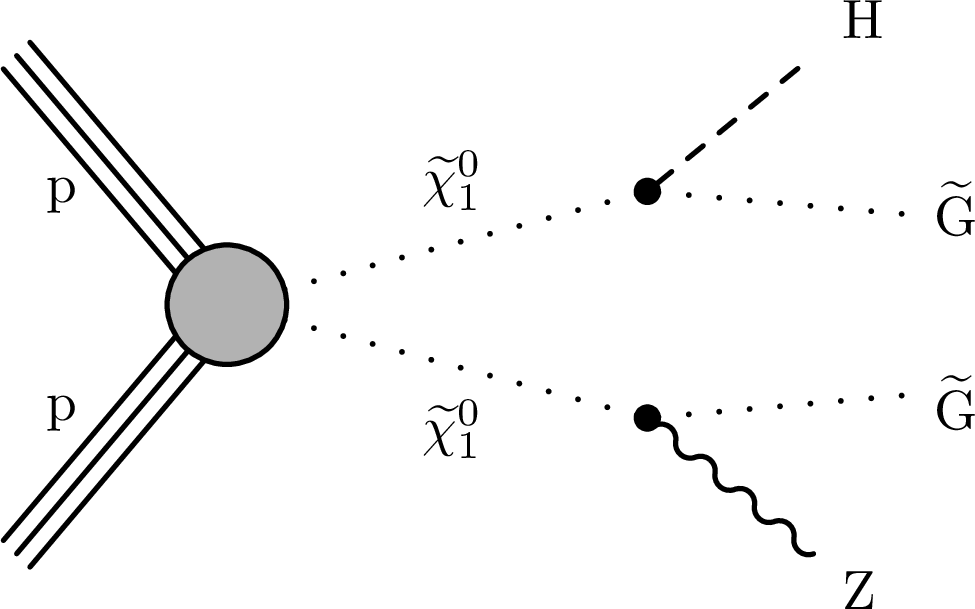
png pdf |
Figure 1-d:
Diagrams displaying the simplified models that are being considered. Upper left: bottom squark pair production; upper right: wino-like chargino-neutralino production; bottom: the two relevant decay modes for higgsino-like neutralino pair production in the GMSB scenario. |

png pdf |
Figure 2:
A flowchart showing the event categorization procedure. |

png pdf |
Figure 3:
The diphoton mass distribution in the search region bin with $ {M_\mathrm {R}} > $ 600 GeV and $ {\mathrm {R}^2} > $ 0.025 in the HighPt category, along with the background-only fit (left) and the signal-plus-background fit (right). The red dot-dashed curve represents the fitted background prediction; the green dashed curve represents the best-fit signal; and the blue solid curve represents the sum of the best-fit signal and the background. |
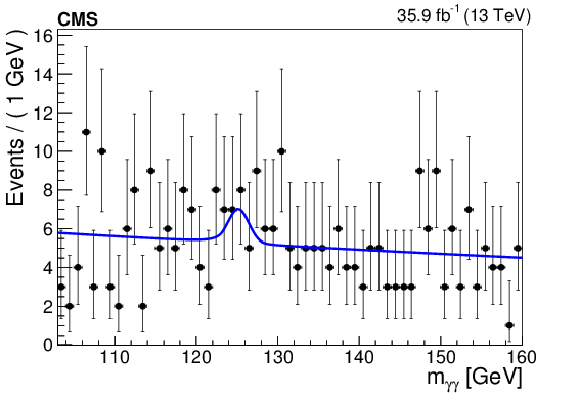
png pdf |
Figure 3-a:
The diphoton mass distribution in the search region bin with $ {M_\mathrm {R}} > $ 600 GeV and $ {\mathrm {R}^2} > $ 0.025 in the HighPt category, along with the signal-plus-background fit. The red dot-dashed curve represents the fitted background prediction; the green dashed curve represents the best-fit signal; and the blue solid curve represents the sum of the best-fit signal and the background. |

png pdf |
Figure 3-b:
The diphoton mass distribution in the search region bin with $ {M_\mathrm {R}} > $ 600 GeV and $ {\mathrm {R}^2} > $ 0.025 in the HighPt category, along with the background-only fit. The red dot-dashed curve represents the fitted background prediction; the green dashed curve represents the best-fit signal; and the blue solid curve represents the sum of the best-fit signal and the background. |
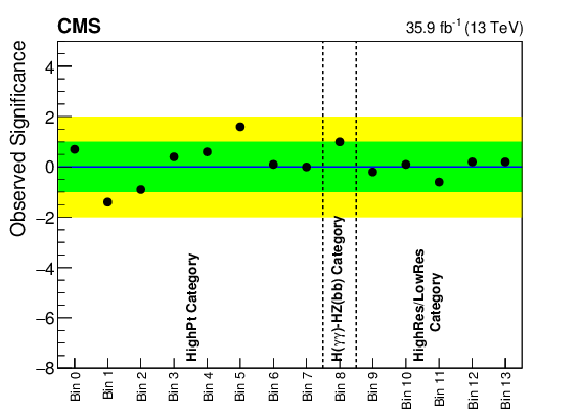
png pdf |
Figure 4:
The observed significance in units of standard deviations is plotted for each search bin. The significance is computed using the profile likelihood, where the sign reflects whether an excess (positive sign) or deficit (negative sign) is observed. The categories that the bins belong to are labeled at the bottom. The bins in the HighRes and LowRes categories are fitted simultaneously and yield a single combined significance. The yellow and green bands represent the $\pm $1 and $\pm $2 standard deviation regions, respectively. |
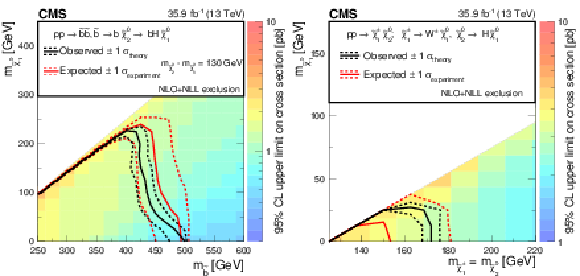
png pdf |
Figure 5:
The observed 95% CL upper limits on the bottom squark pair production cross section (left) and wino-like chargino-neutralino production cross section (right) are shown. The solid and dotted black contours represent the observed exclusion region and its $\pm $1 standard deviations ($1\sigma $) of their experimental and theoretical uncertainties, while the analogous red contours represent the expected exclusion region and its $1\sigma $ band. |
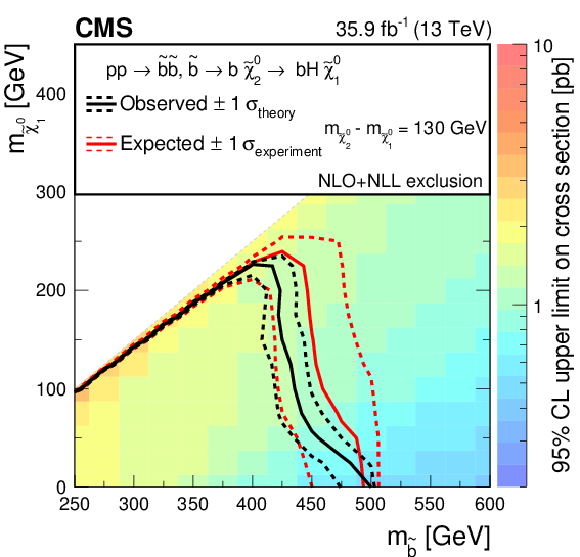
png pdf root |
Figure 5-a:
The observed 95% CL upper limits on the bottom squark pair production cross section are shown. The solid and dotted black contours represent the observed exclusion region and its $\pm $1 standard deviations ($1\sigma $) of their experimental and theoretical uncertainties, while the analogous red contours represent the expected exclusion region and its $1\sigma $ band. |

png pdf root |
Figure 5-b:
The observed 95% CL upper limits on the wino-like chargino-neutralino production cross section are shown. The solid and dotted black contours represent the observed exclusion region and its $\pm $1 standard deviations ($1\sigma $) of their experimental and theoretical uncertainties, while the analogous red contours represent the expected exclusion region and its $1\sigma $ band. |

png pdf |
Figure 6:
The observed 95% CL upper limits on the production cross section for higgsino-like chargino-neutralino production are shown. The charginos and neutralinos undergo several cascade decays producing either Higgs or Z bosons. We present limits in the scenario where the branching fraction of the $\tilde{\chi}^0_1 \to \mathrm{H} \tilde{\mathrm{G}} $ decay is 100% (left) and the scenario where the branching fraction of the $\tilde{\chi}^0_1 \to \mathrm{H} \tilde{\mathrm{G}} $ and $\tilde{\chi}^0_1 \to {\mathrm{Z}} \tilde{\mathrm{G}} $ decays are each 50% (right). The dotted and solid black curves represent the expected and observed exclusion region, and the green and yellow bands represent the $\pm $1 and $\pm $2 standard deviation regions, respectively. The red solid and dotted lines show the theoretical production cross section and its uncertainty band. |

png pdf root |
Figure 6-a:
The observed 95% CL upper limits on the production cross section for higgsino-like chargino-neutralino production are shown. The charginos and neutralinos undergo several cascade decays producing either Higgs or Z bosons. We present limits in the scenario where the branching fraction of the $\tilde{\chi}^0_1 \to \mathrm{H} \tilde{\mathrm{G}} $ decay is 100%. The dotted and solid black curves represent the expected and observed exclusion region, and the green and yellow bands represent the $\pm $1 and $\pm $2 standard deviation regions, respectively. The red solid and dotted lines show the theoretical production cross section and its uncertainty band. |
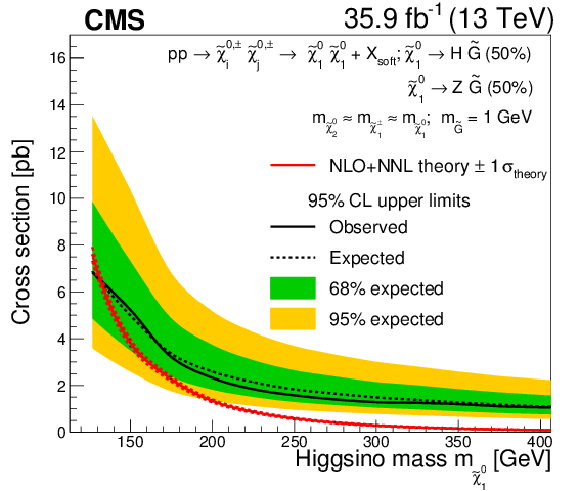
png pdf root |
Figure 6-b:
The observed 95% CL upper limits on the production cross section for higgsino-like chargino-neutralino production are shown. The charginos and neutralinos undergo several cascade decays producing either Higgs or Z bosons. We present limits in the scenario where the branching fraction of the $\tilde{\chi}^0_1 \to \mathrm{H} \tilde{\mathrm{G}} $ and $\tilde{\chi}^0_1 \to {\mathrm{Z}} \tilde{\mathrm{G}} $ decays are each 50%. The dotted and solid black curves represent the expected and observed exclusion region, and the green and yellow bands represent the $\pm $1 and $\pm $2 standard deviation regions, respectively. The red solid and dotted lines show the theoretical production cross section and its uncertainty band. |
| Tables | |
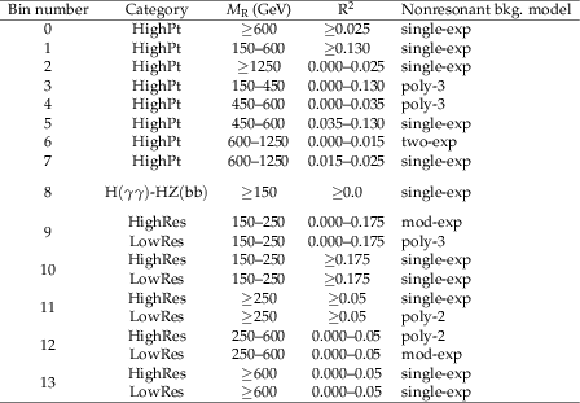
png pdf |
Table 1:
A summary of the search region bins in each category is presented. The functional form used to model the nonresonant background is also listed. An exponential function of the form $ {\mathrm {e}}^{-a m_{\gamma \gamma}}$ is denoted as "single-exp''; a linear combination of two independent exponential functions of the form $ {\mathrm {e}}^{-a m_{\gamma \gamma}}$ and $ {\mathrm {e}}^{-b m_{\gamma \gamma}}$ is denoted as "two-exp''; a modified exponential function of the form $ {\mathrm {e}}^{-a m_{\gamma \gamma}^{b}}$ is denoted as "mod-exp''; and a Bernstein polynomial of degree $n$ [43] is denoted by "poly-n''. The bin labels 9-13 are used for both the HighRes and LowRes categories because the data in these categories are always fitted simultaneously with potentially different nonresonant background models used. Further details on the simultaneous fit are discussed in Section xxxxx. |
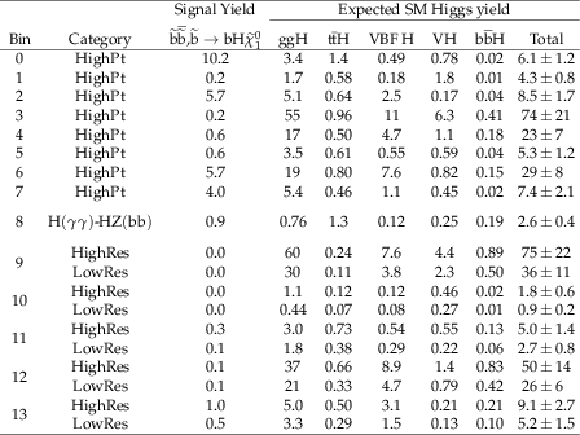
png pdf |
Table 2:
The predicted yields for the SM Higgs boson background processes for each search region are shown for an integrated luminosity corresponding to 35.9 fb$^{-1}$. The contributions from each SM Higgs boson process are shown separately, and the total is shown in the rightmost column, along with its full uncertainty. The bin labels 9-13 are used for both the HighRes and LowRes categories as they are always fitted simultaneously. |
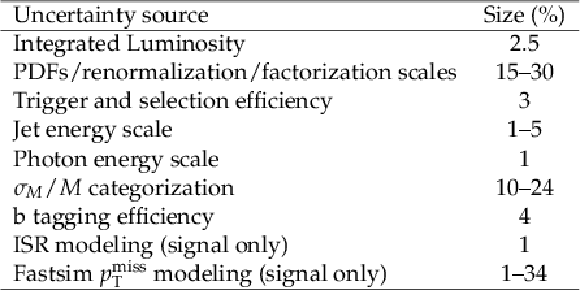
png pdf |
Table 3:
Summary of systematic uncertainties on the SM Higgs background and signal yield predictions, and the size of their effect on the signal yield. |
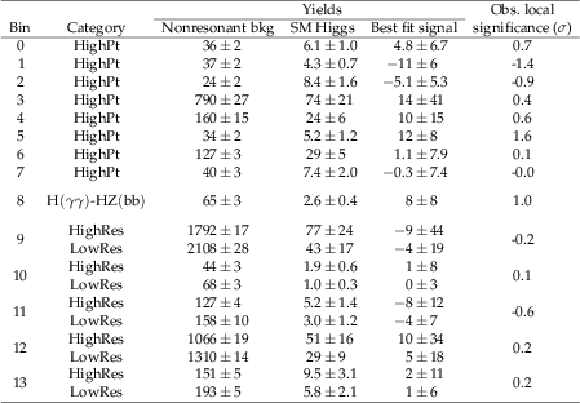
png pdf |
Table 4:
The nonresonant background yields, SM Higgs boson background yields, best fit signal yields, and observed local significance in units of standard deviations ($\sigma $) are shown for the signal plus background fit in each search region bin. The uncertainties include both statistical and systematic components. The nonresonant background yields correspond to the yield within the mass window between 122 and 129 GeV and are intended to estimate the background under the signal peak. The observed significance for the bins in HighRes and LowRes categories are identical because they are the result of a simultaneous fit. The significance is computed using the profile likelihood, where the sign reflects whether an excess (positive sign) or deficit (negative sign) is observed. |
| Summary |
| A search for anomalous Higgs boson production through decays of supersymmetric particles is performed with the proton-proton collision data collected in 2016 by the CMS experiment at the LHC. The sample corresponds to an integrated luminosity of 35.9 fb$^{-1}$ at the center-of-mass energy $\sqrt{s}= $ 13 TeV. Higgs boson candidates are reconstructed from pairs of photons in the central part of the detector. The razor variables ${M_\mathrm{R}} $ and ${\mathrm{R}}$ two are used to suppress Standard Model (SM) Higgs boson production and other SM backgrounds. The non-resonant background is estimated through a fit to the diphoton mass distribution in data, while the SM Higgs background is predicted using simulation. We interpret the results in terms of production cross section limits on simplified models of bottom squark pair production and chargino-neutralino production. We exclude bottom squark masses below 450 GeV for bottom squarks decaying to a bottom quark, a Higgs boson, and the lightest supersymmetric particle (LSP) for LSP masses below 250 GeV. For wino-like chargino-neutralino production, we exclude charginos with mass below 170 GeV for LSP masses below 25 GeV. In the GMSB scenario, we exclude charginos with mass below 205 GeV for neutralinos decaying to a Higgs boson and a goldstino LSP ($\tilde{\mathrm{G}}$) with 100% branching fraction. Finally, we exclude charginos with mass below 130 GeV for the case where the branching fractions of the $\tilde{\chi}^0_1\to \mathrm{H}\tilde{\mathrm{G}}$ and $\tilde{\chi}^0_1\to \mathrm{Z}\tilde{\mathrm{G}}$ decays are 50% each. |
| Additional Figures | |
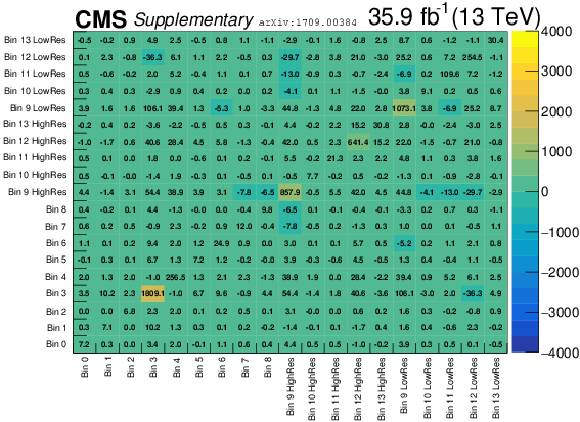
png pdf root |
Additional Figure 1:
The covariance matrix for the background prediction in every search region bin considered in the analysis. |
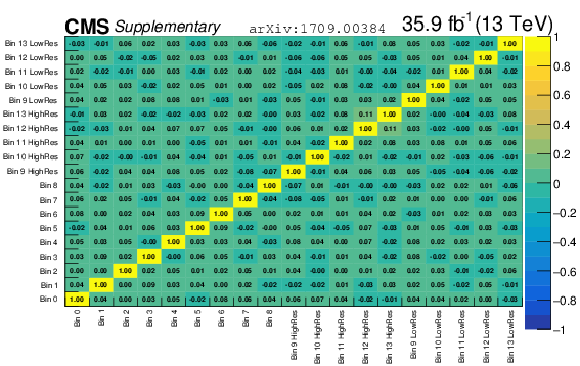
png pdf root |
Additional Figure 2:
The correlation matrix for the background prediction in every search region bin considered in the analysis. |
| Additional Tables | |
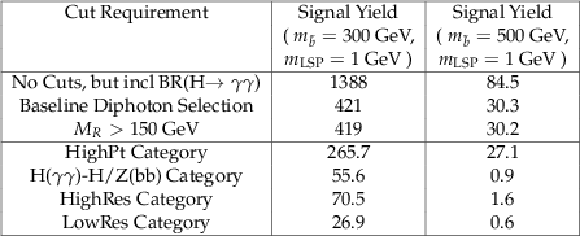
png pdf |
Additional Table 1:
A cut flow table is shown summarizing the expected signal yield for two model points of a simplified model of sbottom pair production in 35.9 fb$^{-1}$ of integrated luminosity at various stages of the event selection. After the baseline cut of $M_{R} > $ 150 GeV, we show the signal yield distributed into the four exclusive search categories. |
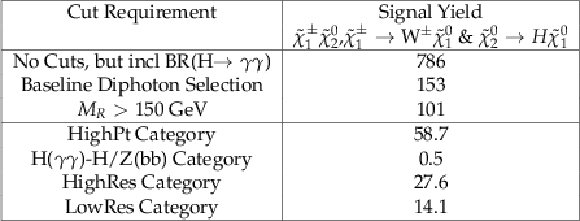
png pdf |
Additional Table 2:
A cut flow table is shown summarizing the expected signal yield for three different simplified model of electroweak SUSY production in 35.9 fb$^{-1}$ of integrated luminosity at various stages of the event selection. The masses of $\tilde{\chi}_{2}^{0}$, $\tilde{\chi}_{1}^{0}$, and $\tilde{\chi}_{1}^{\pm}$ are all 127 GeV, while the mass of the LSP ($\tilde{G}$) is 1 GeV. After the baseline cut of $M_{R} > $ 150 GeV, we show the signal yield distributed into the four exclusive search categories. |

png pdf |
Additional Table 3:
A cut flow table is shown summarizing the expected signal yield for three different simplified model of electroweak SUSY production in 35.9 fb$^{-1}$ of integrated luminosity at various stages of the event selection. The masses of $\tilde{\chi}_{2}^{0}$, $\tilde{\chi}_{1}^{0}$, and $\tilde{\chi}_{1}^{\pm}$ are all 127 GeV, while the mass of the LSP ($\tilde{G}$) is 1 GeV. After the baseline cut of $M_{R} > $ 150 GeV, we show the signal yield distributed into the four exclusive search categories. |
| An example code snippet to compute the variables $ M_{\mathrm {R}} $ and $ R^2 $ is provided at this link. Please see the function ComputeRazorVariables which takes as input TLorentzVector objects for the four-momenta of the two photons from the Higgs decay, a vector of TLorentzVector objects of all jets in the event with transverse momentum larger than 30 GeV, and a TLorentzVector for the missing transverse energy. The variables MR and Rsq are computed and passed by reference. |
| References | ||||
| 1 | ATLAS Collaboration | Observation of a new particle in the search for the Standard Model Higgs boson with the ATLAS detector at the LHC | PLB 716 (2012) 1 | 1207.7214 |
| 2 | CMS Collaboration | Observation of a new boson at a mass of 125 GeV with the CMS experiment at the LHC | PLB 716 (2012) 30 | CMS-HIG-12-028 1207.7235 |
| 3 | CMS Collaboration | Observation of a new boson with mass near 125 GeV in pp collisions at $ \sqrt{s} = $ 7 and 8 TeV | JHEP 06 (2013) 081 | CMS-HIG-12-036 1303.4571 |
| 4 | M. Monaco, M. Pierini, A. Romanino, and M. Spinrath | Phenomenology of minimal unified tree level gauge mediation at the LHC | JHEP 07 (2013) 078 | 1302.1305 |
| 5 | J. Duarte et al. | Squark-mediated Higgs+jets production at the LHC | 1703.06544 | |
| 6 | S. Dimopoulos and H. Georgi | Softly broken supersymmetry and SU(5) | NPB 193 (1981) 150 | |
| 7 | S. Dimopoulos, M. Dine, S. Raby, and S. D. Thomas | Experimental signatures of low-energy gauge mediated supersymmetry breaking | PRL 76 (1996) 3494 | hep-ph/9601367 |
| 8 | K. T. Matchev and S. D. Thomas | Higgs and $ Z $ boson signatures of supersymmetry | PRD 62 (2000) 077702 | hep-ph/9908482 |
| 9 | LHC New Physics Working Group, D. Alves et al. | Simplified models for LHC new physics searches | JPG 39 (2012) 105005 | 1105.2838 |
| 10 | ATLAS Collaboration | Search for direct pair production of a chargino and a neutralino decaying to the 125 GeV Higgs boson in $ \sqrt{s} = 8 TeV {pp} $ collisions with the ATLAS detector | EPJC 75 (2015), no. 5, 208 | 1501.07110 |
| 11 | CMS Collaboration | Searches for electroweak neutralino and chargino production in channels with Higgs, Z, and W bosons in pp collisions at 8 TeV | PRD 90 (2014), no. 9, 092007 | CMS-SUS-14-002 1409.3168 |
| 12 | CMS Collaboration | Search for SUSY with Higgs in the diphoton final state using the razor variables | CMS-PAS-SUS-14-017 | CMS-PAS-SUS-14-017 |
| 13 | CMS Collaboration | CMS luminosity measurement for the 2016 data taking period | CMS-PAS-LUM-17-001 | CMS-PAS-LUM-17-001 |
| 14 | CMS Collaboration | Inclusive search for supersymmetry using the razor variables in $ {\mathrm{p}} {\mathrm{p}} $ collisions at $ \sqrt{s} = $ 7 TeV | PRL 111 (2013) 081802 | CMS-SUS-11-024 1212.6961 |
| 15 | CMS Collaboration | Search for supersymmetry with razor variables in $ {\mathrm{p}} {\mathrm{p}} $ collisions at $ \sqrt{s} = $ 7 TeV | PRD 90 (2014) 112001 | CMS-SUS-12-005 1405.3961 |
| 16 | CMS Collaboration | The CMS experiment at the CERN LHC | JINST 3 (2008) S08004 | CMS-00-001 |
| 17 | CMS Collaboration | Measurements of properties of the Higgs boson in the diphoton decay channel with the full 2016 data set | CMS-PAS-HIG-16-040 | CMS-PAS-HIG-16-040 |
| 18 | CMS Collaboration | Particle-flow reconstruction and global event description with the CMS detector | JINST 12 (2017) P10003 | CMS-PRF-14-001 1706.04965 |
| 19 | CMS Collaboration | Performance of photon reconstruction and identification with the CMS detector in proton-proton collisions at $ \sqrt{s} = $ 8 TeV | JINST 10 (2015) P08010 | CMS-EGM-14-001 1502.02702 |
| 20 | CMS Collaboration | Electron and photon performance in CMS with the full 2016 data sample | CDS | |
| 21 | M. Cacciari, G. P. Salam, and G. Soyez | The anti-$ k_t $ jet clustering algorithm | JHEP 04 (2008) 063 | 0802.1189 |
| 22 | M. Cacciari, G. P. Salam, and G. Soyez | FastJet user manual | EPJC 72 (2012) 1896 | 1111.6097 |
| 23 | CMS Collaboration | Jet energy scale and resolution in the CMS experiment in pp collisions at 8 TeV | JINST 12 (2017) P02014 | CMS-JME-13-004 1607.03663 |
| 24 | CMS Collaboration | Identification of b quark jets at the CMS experiment in the LHC Run 2 | CMS-PAS-JME-14-001 | CMS-PAS-JME-14-001 |
| 25 | CMS Collaboration | Missing transverse energy performance of the CMS detector | JINST 6 (2011) P09001 | CMS-JME-10-009 1106.5048 |
| 26 | CMS Collaboration | Search for new physics in the multijet and missing transverse momentum final state in proton-proton collisions at $ \sqrt{s} = $ 7 TeV | PRL 109 (2012) 171803 | CMS-SUS-12-011 1207.1898 |
| 27 | CMS Collaboration | Performance of the CMS missing transverse momentum reconstruction in $ {\mathrm{p}} {\mathrm{p}} $ data at $ \sqrt{s} = $ 8 TeV | JINST 10 (2015) P02006 | CMS-JME-13-003 1411.0511 |
| 28 | J. Alwall et al. | The automated computation of tree-level and next-to-leading order differential cross sections, and their matching to parton shower simulations | JHEP 07 (2014) 079 | 1405.0301 |
| 29 | ATLAS, CMS Collaboration | Combined measurement of the Higgs boson mass in $ pp $ collisions at $ \sqrt{s}= $ 7 and 8 TeV with the ATLAS and CMS experiments | PRL 114 (2015) 191803 | 1503.07589 |
| 30 | R. Frederix and S. Frixione | Merging meets matching in MC@NLO | JHEP 12 (2012) 061 | 1209.6215 |
| 31 | J. Alwall et al. | Comparative study of various algorithms for the merging of parton showers and matrix elements in hadronic collisions | EPJC 53 (2008) 473 | 0706.2569 |
| 32 | T. Sjostrand, S. Mrenna, and P. Skands | A brief introduction to PYTHIA 8.1 | Comp. Phys. Commun. 178 (2008) 852 | |
| 33 | P. Skands, S. Carrazza, and J. Rojo | Tuning PYTHIA 8.1: the Monash 2013 tune | EPJC 74 (2014) 3024 | |
| 34 | NNPDF Collaboration | Parton distributions for the LHC Run II | JHEP 04 (2015) 040 | 1410.8849 |
| 35 | GEANT4 Collaboration | GEANT4---a simulation toolkit | NIMA 506 (2003) 250 | |
| 36 | S. Abdullin et al. | The fast simulation of the CMS detector at LHC | J. Phys.: Conf. Ser. 331 (2011) 032049 | |
| 37 | D. de Florian et al. | Handbook of LHC Higgs cross sections: 4. deciphering the nature of the Higgs sector | CERN-2017-002-M | 1610.07922 |
| 38 | W. Beenakker, R. Hopker, M. Spira, and P. M. Zerwas | Squark and gluino production at hadron colliders | NPB 492 (1997) 51 | hep-ph/9610490 |
| 39 | A. Kulesza and L. Motyka | Threshold resummation for squark-antisquark and gluino-pair production at the LHC | PRL 102 (2009) 111802 | 0807.2405 |
| 40 | A. Kulesza and L. Motyka | Soft gluon resummation for the production of gluino-gluino and squark-antisquark pairs at the LHC | PRD 80 (2009) 095004 | 0905.4749 |
| 41 | W. Beenakker et al. | Soft-gluon resummation for squark and gluino hadroproduction | JHEP 12 (2009) 041 | 0909.4418 |
| 42 | W. Beenakker et al. | Squark and gluino hadroproduction | Int. J. Mod. Phys. A 26 (2011) 2637 | 1105.1110 |
| 43 | C. Borschensky et al. | Squark and gluino production cross sections in $ pp $ collisions at $ \sqrt{s} = $ 13, 14, 33 and 100 TeV | EPJC 74 (2014) 3174 | 1407.5066 |
| 44 | CMS Collaboration | Observation of the diphoton decay of the Higgs boson and measurement of its properties | EPJC 74 (2014) 3076 | CMS-HIG-13-001 1407.0558 |
| 45 | H. Akaike | A new look at the statistical model identification | IEEE Transactions on Automatic Control 19-6 (1974) 716 | |
| 46 | M. J. Oreglia | A study of the reactions $\psi' \to \gamma\gamma \psi$ | PhD thesis, Stanford University, 1980 SLAC Report SLAC-R-236, see Appendix D | |
| 47 | J. Gaiser | Charmonium Spectroscopy From Radiative Decays of the $\mathrm{J}/\psi$ and $\psi'$ | PhD thesis, SLAC | |
| 48 | W. Beenakker et al. | Production of charginos, neutralinos, and sleptons at hadron colliders | PRL 83 (1999) 3780 | hep-ph/9906298 |
| 49 | B. Fuks, M. Klasen, D. R. Lamprea, and M. Rothering | Gaugino production in proton-proton collisions at a center-of-mass energy of 8 TeV | JHEP 10 (2012) 081 | 1207.2159 |
| 50 | B. Fuks, M. Klasen, D. R. Lamprea, and M. Rothering | Precision predictions for electroweak superpartner production at hadron colliders with Resummino | EPJC 73 (2013) 2480 | 1304.0790 |
| 51 | P. Z. Skands and Others | SUSY Les Houches accord: interfacing SUSY spectrum calculators, decay packages, and event generators | JHEP 07 (2004) 036 | Hep-Ph/0311123 |
| 52 | A. L. Read | Presentation of search results: the $ CL_s $ technique | in Durham IPPP Workshop: Advanced Statistical Techniques in Particle Physics, p. 2693 Durham, UK, March, 2002 [JPG 28 (2002) 2693] | |
| 53 | T. Junk | Confidence level computation for combining searches with small statistics | NIMA 434 (1999) 435 | hep-ex/9902006 |
| 54 | ATLAS and CMS Collaborations | Procedure for the LHC Higgs boson search combination in summer 2011 | CMS-NOTE-2011-005 | |
| 55 | G. Cowan, K. Cranmer, E. Gross, and O. Vitells | Asymptotic formulae for likelihood-based tests of new physics | EPJC 71 (2011) 1554 | 1007.1727 |

|
Compact Muon Solenoid LHC, CERN |

|

|

|

|

|

|